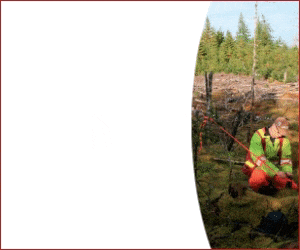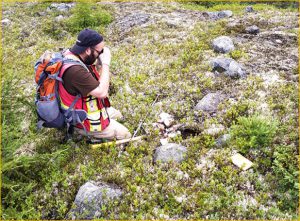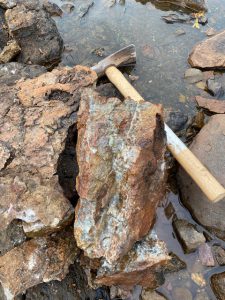Central Newfoundland Gold Belt becoming major gold camp

The Canadian Maritime province of Newfoundland and Labrador has caught the eye of both resource stock investors and explorers, in particular, gold discoveries on the Island of Newfoundland.
The Newfoundland gold play is focused on a large southwest to northeast-trending region known as the Central Newfoundland Gold Belt (CNGB) that stretches almost across the entire island, almost 250 km in length, where a claim staking rush has been taking place.
This isn’t to say that gold is not found elsewhere on the island. There has been gold mining in Newfoundland for many years. On the Baie Verte Peninsula on the north coast, there was the Rambler Mine and a few other companies that mined narrow, high-grade veins.
The current major player in the CNGB with the most advanced project is Marathon Gold’s Valentine Gold Project, a large tonnage, open pit project.
“Over the past 10 years, Marathon Gold’s success has opened people’s eyes to the potential for Newfoundland – and the Maritimes in general – to host large scale gold deposits,” said Matt Manson President and CEO.
Considering the success of Marathon – and more recently Sokoman Minerals and New Found Gold – Manson considers the entire Central Newfoundland Gold Belt prospective. “Because the area of central Newfoundland was dominated by base metal mining for so many years such as the long-life Buchans Mine, a lot of the historical exploration was for base metals back in the 1980s,” said Manson. “Looking at the perspective of large, open pittable gold deposits, that’s relatively new. When Noranda drilled some years, ago, they didn’t have the modern perspective that we have now. The new geological model has certainly borne fruit.”
Being in the North Atlantic region, Newfoundland’s weather is highly variable – it can snow one day and rain the next – however, exploration and mining can be carried out all year round except for ground-based prospecting when there is snow cover.
Mining is one of Newfoundland and Labrador’s largest and oldest industries, and a major contributor to the economy of the province. More than fifteen mineral commodities have been produced or mined in the province.
With the province’s economy being resource-based for many years, the provincial government has the reputation of supporting responsible resource development. The Newfoundland and Labrador government as well as the province’s communities are familiar with exploration and mining and are on board when things are done in a socially acceptable manner, resulting in the province becoming one of the best mining jurisdictions in the world.
The current exploration activity in the Central Newfoundland Gold Belt presents a solid opportunity for mining stock investors. This gold play has legs and a long way to go as the camp develops.
 Marathon Gold Corp. [MOZ-TSX; MGDPF-OTCQX]Â has a 100% interest in the advanced-stage Valentine Gold Project located 55 km south of Buchans, west-central Newfoundland. The project is situated in the heart of the emerging southwest to northeast-trending Central Newfoundland Gold Belt.
Marathon Gold Corp. [MOZ-TSX; MGDPF-OTCQX]Â has a 100% interest in the advanced-stage Valentine Gold Project located 55 km south of Buchans, west-central Newfoundland. The project is situated in the heart of the emerging southwest to northeast-trending Central Newfoundland Gold Belt.
Based on the Prefeasibility Study released in April, 2020 the project is expected to have substantial economic benefits for both Newfoundland and Canada during 15 years of construction, operation and rehabilitation.
The open pit project is the largest undeveloped gold resource in Atlantic Canada. The Prefeasibility Study outlined an open-pit mining and conventional milling operation over a 12-year mine life with a 36% after-tax Internal Rate of Return using a US$1,350/oz gold price assumption. The project has estimated Proven Reserves of 1.3 million oz (26.3 Mt at 1.52 g/t gold) and Probable Reserves of 600,000 oz (14.8 Mt t at 1.23 g/t gold). Total Measured Resources (inclusive of reserves) comprise 1.9 million oz (31.7 Mt t at 1.86 g/t gold) with Indicated Resources (inclusive of the mineral reserves) of 1.19 million oz (23.2 Mt t at 1.60 g/t). Additional Inferred Resources stand at 960,000 oz (16.77 Mt t at 1.78 g/t gold).
The April PFS showed a 12-year mine life at a production rate of 175,000 ounces of gold annually in years 1 to 9. After-tax IRR is 36% with a NPV5% of $472 million at an All-In Sustaining Cost of US$739/oz.
With a relatively modest Capex of $272 million, Marathon Gold management is of the view they won’t need to bring in a senior partner.
Matt Manson, President and CEO of Marathon Gold Corp., said, “With a combination of debt and equity financing, we can take on the Capex funding requirements ourselves.”
The company’s strategy is to build and operate the mine themselves. Being a possible takeover target, if Marathon receives a compelling offer, they would take it to shareholders for acceptance or rejection.
The project comprises a series of four mineralized deposits along a 20-kilometre shear zone-hosted mineralized system. A 44,000-metre, $9.7 million drilling program is planned to test the prospective gold targets along the trend where current drilling is testing a 6-km stretch between the Leprechaun and Marathon deposits. The company considers exploration to be an important part of their story.
As such, an 8,000-metre infill drilling program is testing the Berry Zone where recent drill results have included  3.3 g/t gold over 120 metres, 1.47 g/t gold over 111 metres and 2.61 g/t gold over 85 metres.
Marathon recently filed its environmental impact statement (EIS) that assesses the potential environmental and social effects of the project in 15 separate areas of study, including water and air quality, wildlife, vegetation and wetlands, fish and fish habitat, communities, indigenous groups, and the regional and provincial economies. A Feasibility Study is ongoing.
There are two different access roads to the Valentine Gold Project and a power line will be built by the local utility, Newfoundland and Labrador Hydro, along with the appropriate transformers to run the 30 kilometres from the Hydro substation to the mine site.
The project will generate substantial economic benefits (utilizing a gold price assumption of US$1,350/oz), including creation of over 19,000 person years of total employment in Canada (direct, indirect and induced), including approximately 11,000 person-years in Newfoundland and an average annual employment of nearly 1,300 person-years of employment in Canada, including an annual average of 725 person-years within Newfoundland.
The Valentine Gold Project will generate approximately $1.3-billion in income to workers and businesses within Canada, including $750-million to workers and businesses located within Newfoundland and contribute $3.6-billion to Canada’s gross domestic product (GDP), which includes $2.9-billion to Newfoundland’s gross domestic product. Federal government revenues will be about $292-million with some $400 million to the treasury of Newfoundland.
Marathon gold has 207,925,419 shares outstanding and approximately $54 million in its treasury. The company’s Valentine Gold Project is the “anchor” in the Newfoundland gold play. Its success has spurred a number of other gold explorers to participate in this fast-developing important gold camp in a world-leading mining jurisdiction.
 Sokoman Minerals Corp. [SIC-TSXV; SICNF-OTCQB] is currently conducting a Phase 6, 10,000-metre, diamond drilling program at its flagship Moosehead gold project in Newfoundland. The 100%-owned Moosehead Project is located along the Trans-Canada Highway in north-central Newfoundland, on the same trend as the advanced Valentine Lake Project (Marathon Gold), and adjacent to New Found Gold’s Queensway Project.
Sokoman Minerals Corp. [SIC-TSXV; SICNF-OTCQB] is currently conducting a Phase 6, 10,000-metre, diamond drilling program at its flagship Moosehead gold project in Newfoundland. The 100%-owned Moosehead Project is located along the Trans-Canada Highway in north-central Newfoundland, on the same trend as the advanced Valentine Lake Project (Marathon Gold), and adjacent to New Found Gold’s Queensway Project.
Tim Froude, President and CEO, said, “While we will be testing several concepts, the program will have a strong focus on the Eastern Trend, including the down-dip and along-strike extensions. Plans include testing of the 400-metre vertical level along a 200-metre section of the interpreted Eastern Trend structure, with holes also testing for high-grade mineralization at the 250, 300 and 350-metre levels. It’s time to test this system at depth, and we have sufficient funding to do that.”
At the Moosehead Project, Sokoman is targeting high-grade, turbidite-hosted, Australian Fosterville-type gold mineralization. Since acquiring the project in 2018, Sokoman has consistently produced outstanding drill results including the following Eastern Trend highlights from the five Phases completed to date:
• Phase 1 MH-18-01: 11.90 metres of 44.96 g/t gold, including 5.65 metres of 93.56 g/t gold.
• Phase 2 MH-18-39: 5.10 metres of 124.20 g/t gold, including 1.10 metres of 550.30 g/t gold.
• Phase 3 MH-19-62: 7.20 metres of 22.35 g/t gold, including 4.80 metres of 33.59 g/t gold.
• Phase 4 MH-19-81: 6.40 metres of 17.34 g/t gold, including 1.45 metres of 75.50 g/t gold.
• Phase 5 MH-20-86: 5.20 metres of16.85 g/t gold, including 1.35 metres of 61.11 g/t gold.
Reported lengths are core lengths believed to be 70% – 90% of true thicknesses.
 Recent prospecting at South Pond, 400 metres along strike to the southwest of Eastern Trend has located a cluster of angular quartz float with high-grade grab samples ranging from 0.318 to 157.04 g/t gold and silver values up to 36.2 g/t.
Recent prospecting at South Pond, 400 metres along strike to the southwest of Eastern Trend has located a cluster of angular quartz float with high-grade grab samples ranging from 0.318 to 157.04 g/t gold and silver values up to 36.2 g/t.
Several holes will be testing for the down-dip extension of the Western Trend, as well as select reconnaissance holes testing high-priority geochemical targets elsewhere on the property including South Pond.
Mineralization has been defined over a 500-metre strike length and a 200-metre vertical height and remains open for expansion.
The Moosehead Project features year-round road access, abundant internal and logging roads, a one-hour drive to an assay lab and a provincial power sub-station 4 km to the west.
Sokoman also has a 100% interest in an early-stage antimony/gold project in Newfoundland recently optioned to White Metal Resources Inc. In Labrador, the company has a 100% interest in the Iron Horse (Fe) Project.
Sokoman Minerals has 123.2 million shares outstanding and was named 2019 Explorer of the Year by the Canadian Institute of Mining, Newfoundland and Labrador Branch.
With its numerous high-grade gold assays, Sokoman is one of the reasons there has been a claim staking rush in central Newfoundland. Clearly, the company is on track for defining a robust and extensive gold mineralizing system at its Moosehead Project.
 Cartier Iron Corporation [CFE-CSE] is an exploration and development company working to capitalize on renewed investor interest in precious metals and iron ore.
Cartier Iron Corporation [CFE-CSE] is an exploration and development company working to capitalize on renewed investor interest in precious metals and iron ore.
It aims to achieve that goal by advancing a highly promising gold project in Newfoundland while developing significant iron ore resources in one of Canada’s premier iron ore mining districts in Quebec.
Its key properties are the Big Easy Gold Project on the Burin Peninsula in eastern Newfoundland and the Gagnon Holdings Iron Project in Quebec, where Cartier is working in a joint venture with Champion Iron Ltd. [CIA-TSX, ASX], a company that also holds a 17% stake in Cartier.
Based in Toronto, Cartier is led by CEO Thomas Larsen, who has over 35 years of experience in the investment industry, specializing in corporate finance and the management of junior mining companies.
Dr. William Pearson, P. Geo., the company’s chief technical advisor, was involved in the value creation that led to the acquisition of Desert Sun Mining Corp. by Yamana Gold Inc. in 2006 and Central Sun Mining by B2Gold Corp. in 2009.
Cartier has been focusing on the Big Easy, which hosts an extensive, but under-explored low-sulphidation, epithermal gold-silver system that occurs on a prominent boundary between volcanic and sedimentary rocks in the Neoproterozoic Avalon zone in the Burin Peninsula.
 Covering 152.3 km2, Big Easy is situated east of the former Hope Brook gold mine, which produced 752,163 ounces of gold between 1987 and 1997. The geological setting that is considered similar to that of OceanaGold Corporation’s producing Haile gold mine in South Carolina.
Covering 152.3 km2, Big Easy is situated east of the former Hope Brook gold mine, which produced 752,163 ounces of gold between 1987 and 1997. The geological setting that is considered similar to that of OceanaGold Corporation’s producing Haile gold mine in South Carolina.
Under a November, 2017, agreement that was subsequently amended, Cartier can earn a 100% interest in the property by spending $2 million by September, 2023 and issuing 2.5 million shares to the vendor, whereby 1.5 million of the shares have already been issued and over $500,000 spent to date.
While Big Easy was discovered in 1996, exploration is still at an early stage. From 2010 to 2016, drilling on the property (31 holes or 6,497 metres) outlined an extensive mineralized zone, approximately 300 to 400 metres wide with a prospective strike length of at least 5 km. Significant historical results include 6.05 g/t gold and 174 g/t silver over 1.5 metres.
In May, 2018, Cartier said an induced polarization (IP)/resistivity survey highlighted an extensive mineralized epithermal system, containing two major showings – the Big Easy and ET zones – located 3.5 km apart, as well as new targets across a 4-km strike length. IP surveys also outlined a chargeability anomaly that extends 4 km along strike from the Big Easy and ET showings.
In December, 2018, the company said a drill program comprised of four holes (1,249 metres) intersected a major new anomalous alteration zone, grading 0.11 g/t gold and 2.65 g/t silver over 180.4 metres on the western edge of the Central chargeability anomaly.
Subsequent exploration has suggested that the potential overall strike length of the target zone for low sulphidation epithermal gold-silver mineralization may be more than 20 km.
After staking additional claims, Cartier has obtained permits to carry out a 1,000-metre drill program on the Central Anomaly in early 2021, and will also do additional IP/RES surveys at that time. Depending on the results from the IP/Res surveys, drilling may be further expanded.
To fund that work, the company recently raised $1.3 million from a non-brokered private placement of 18.5 million units at $0.07 per unit. Each unit consists of one common share and one common share purchase warrant entitling the holder to buy one common share at 10 cents for a term of 36 months from the issue date.
On Friday, October 16, shares were trading at $0.075 in a 52-week range of $0.11 and $0.03.
Aside from Big Easy, the company has a portfolio of highly prospective iron-rich mineral concessions in the southern Labrador Trough, Canada’s premier iron ore mining district. They include the 55%-owned Lac Penguin Iron Project. Penguin consists of 141 claims covering 75 km2 located near several iron ore mines. It contains an inferred mineral resource of 531 million tonnes, grading 33% FeT (Total Iron).
Metallurgical tests indicate that a high-quality iron concentrate very low in deleterious elements, grading 64-66% Fe, can be produced from Lac Penguin composite samples. Cartier’s next steps to advance the Lac Penguin deposit would consist of definition drilling, mineralogical studies and preliminary metallurgical testing.
 TRU Precious Metals Corp. [TRU-TSXV], formerly Trius Investments Inc., is setting up to explore its recently acquired gold prospects in the Central Newfoundland Gold Belt where significant gold discoveries have been made and a great deal of exploration activity is currently taking place.
TRU Precious Metals Corp. [TRU-TSXV], formerly Trius Investments Inc., is setting up to explore its recently acquired gold prospects in the Central Newfoundland Gold Belt where significant gold discoveries have been made and a great deal of exploration activity is currently taking place.
TRU is a portfolio company of Resurgent Capital Corp., a merchant bank that provides advisory services and financing to venture capital markets, in this case, a junior exploration company. Thanks to a backdrop of macroeconomic and monetary policy favourable to gold, TRU is seeking unique value-creation opportunities and is currently increasing its exposure to the precious metals sector by assembling a portfolio of gold exploration properties in the Central Newfoundland Gold Belt, one of the hottest exploration plays in Canada.
Geological mineralizing events commonly take place over large areas, thus creating a “mining camp” and with New Found Gold’s Queensway Project returning drill results that included 41.2 g/t gold over 4.75 metres and 25.4 g/t gold over 5.15 metres, this is an encouraging sign for other Newfoundland Gold Belt explorers.
As noted above, Marathon Gold has been building gold resources at its Valentine Lake Project in the Central Newfoundland Gold Belt which hosts one of the largest undeveloped gold resources in Atlantic Canada.
 TRU recently entered into a binding Letter of Intent to indirectly purchase 65 mineral claims in central Newfoundland known as the Twilite Gold Project, along with all related permits and technical data. This drill-ready project, comprising 65 units covering 1,625 hectares, is located about 30 km from the Sokoman Minerals Moosehead Gold Project. Moosehead Gold has returned drill results of 11.9 metres grading 44.96 g/t gold. Twilite Gold is considered to be associated with a low sulphidation gold system and shares many characteristics with Sokoman’s Moosehead Gold Project.
TRU recently entered into a binding Letter of Intent to indirectly purchase 65 mineral claims in central Newfoundland known as the Twilite Gold Project, along with all related permits and technical data. This drill-ready project, comprising 65 units covering 1,625 hectares, is located about 30 km from the Sokoman Minerals Moosehead Gold Project. Moosehead Gold has returned drill results of 11.9 metres grading 44.96 g/t gold. Twilite Gold is considered to be associated with a low sulphidation gold system and shares many characteristics with Sokoman’s Moosehead Gold Project.
TRU President and CEO, Joel Freudman, commented: “We’re excited to acquire Twilite Gold, which nicely aligns with our previously communicated strategy of acquiring a more advanced exploration-stage asset in the Central Newfoundland Gold Belt at competitive commercial terms. Twilite Gold has some promising historical exploration results and is in the vicinity of other large gold discoveries, which we believe bodes well for Twilite Gold’s investment potential.”
The most recent notable program at Twilite Gold was in 2003 by Altius Resources. Highlights of historical exploration conducted by Fort Knox Gold Resources and Altius included grab samples from Twilite Gold’s Discovery prospect containing visible gold with values up to 202 g/t gold in a zone of quartz veining and silicification. Channel samples returned 3.48 g/t gold and 5.3 g/t gold in a contiguous 1.0-metre sample across the widest portion of the vein. At Twilite Gold’s Spring Pit prospect, diamond drill hole TL-99-10 intersected 5.1 g/t gold over 5.8 metres, from 14.2 to 20 metres in depth.
TRU has also acquired an earlier stage gold prospect in central Newfoundland. The Gander West exploration property is located approximately 16 km from the centre of New Found Gold’s Queensway Project and consists of 120 claims covering 3,000 hectares of unexplored prospective ground.
The Gander West property is within a well-known gold belt. High-grade gold occurrences (greater than 50 g/t gold in grab samples) occur in quartz veins 2.5 km southwest of the Gander West property. The property is already permitted for exploration, including ground geophysics, geochemical surveys and prospecting.
TRU Precious Metals has assembled geologically prospective claim groups in one of Canada’s most attractive gold belts that is gradually revealing the large scale of a number of significant mineral deposits as well as having excellent potential for new discoveries in the pro-mining jurisdiction of Newfoundland.
TRU has 23,445,841 shares outstanding.
We seek Safe Harbor

